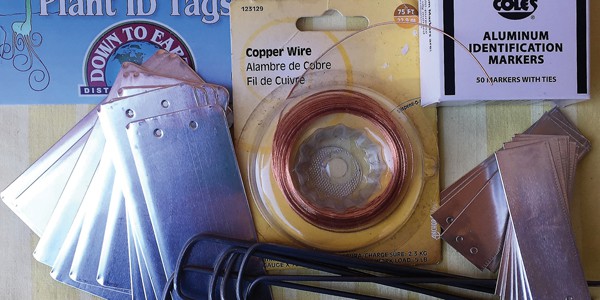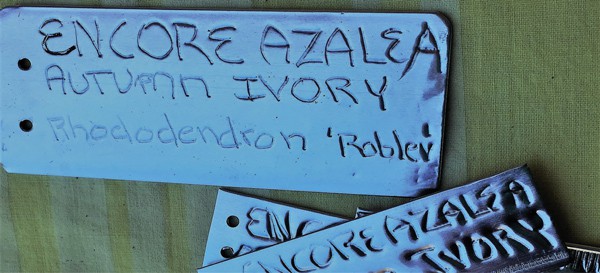By Mary-Kate Mackey

We’ve had a cold wet spring in the Pacific Northwest. I live at the southern end of the Willamette Valley in Oregon, at 1100 feet elevation. Sometimes, my garden experiences snow when it’s raining on the valley floor. This year, we had repeated snows. Some of my Encore®Azaleas lost buds. However, their vigor means more blooms pushed behind those that were gone.
So, while waiting for the spring burst of color, I began permanently tagging my Encores. As a long-time gardener, I’ve attempted all kinds of tagging. Forget anything made of wood. Plastic’s too brittle, no matter how sun-resistant, and the markings fade. Those small white nursery tags last for a while – sometimes I use them to identify a plant until it settles in, because I hate going to the trouble of making a marker, only to find the plant has turned toes up. And creating tags is a bit of trouble.
But it’s worth it.

I now use aluminum tags. The best ones wrap around a thin piece of cardboard, which allows me to write on both sides, pressing with a pen or pencil into the soft metal. I mostly buy packs of 50, measuring 1 by 3 inches. Sometimes I get a larger size in packs of 10, 1 ½ by 3 ¾ inches. You can put a surprising amount of information even on the smaller ones. And they last. I’ve discovered aluminum tags on trees I planted 25 years ago – still telling me what I need to know.
Here’s what I write:
I put the plant’s name on the front in large, clear letters – the tag’s no good if I can’t read my own writing. On the back I include the eventual height and width. That’s always important when I’m later cramming more plants around a specimen. I put an abbreviation that tells me where I got it. If it thrives, I may want more. And last, I press in the month and year it goes into the ground or container.
On the larger tags, I add the Latin name after the trade name, and on the back, I write in any characteristics, like deciduous or evergreen. That way I’ll know if that bare stick in the ground is normal.
The attachment tie wires sold with the tags have a history of failing after a few years. So now I cut a small strand of copper wire to fasten the marker to a branch. Or, with my Encores, I wire the tag to an earth staple and stick it halfway in the ground behind each plant. The staples will rust, but that makes them less noticeable. Earth staple markers also work well for noting the location of any plant that disappears during part of the season.
Over the years, I’ve inadvertently stepped on stapled tags, crushing them. But interestingly, if I unbend the tag and wipe it off, the mud embeds in the writing, making it even easier to read.
OK, Encore Azaleas, it’s time for your show. Tag – you’re it!